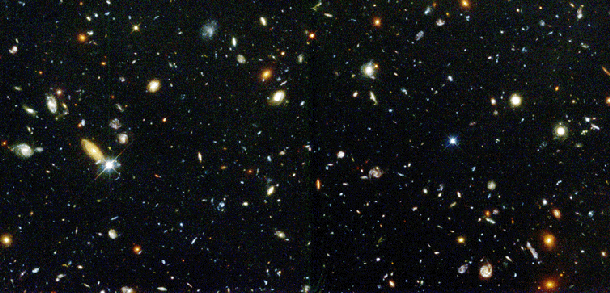Astronomy Picture of the Day
Discover the cosmos! Each day we feature a different image or photograph
of our fascinating universe, along with a brief explanation written by a
professional astronomer.
January 24, 1996

The Deep Field
Credit:
R. Williams,
The HDF Team
(STScI),
NASA,
Explanation:
The image above is part of the
Hubble Deep Field and represents
humanity's most distant yet
optical view of the Universe. Galaxies like
colorful pieces of candy fill the field, some as faint as 30th magnitude
(about four billion times fainter than stars visible to the unaided eye).
The dimmest objects are the most distant galaxies and reveal what
the Universe looked like in the
extremely distant past, perhaps less than one billion years after the
Big Bang.
To make the Deep Field image, astronomers selected an uncluttered
area of the sky in the
constellation
Ursa Major (the Big Dipper) and
pointed the Hubble Space Telescope
at a single spot for 10 days accumulating and combining
many separate exposures. With each additional exposure, fainter
objects were revealed.
The final result can be used to explore the
mysteries of galaxy evolution and the infant Universe.
Tomorrow's picture: Catching Falling Stardust
| Archive
| Index
| Glossary
| Education
| About APOD |




Authors & editors:
Robert Nemiroff
(GMU) &
Jerry
Bonnell (USRA).
NASA Technical Rep.:
Sherri
Calvo.
Specific rights apply.
A service of:
LHEA
at
NASA/
GSFC




